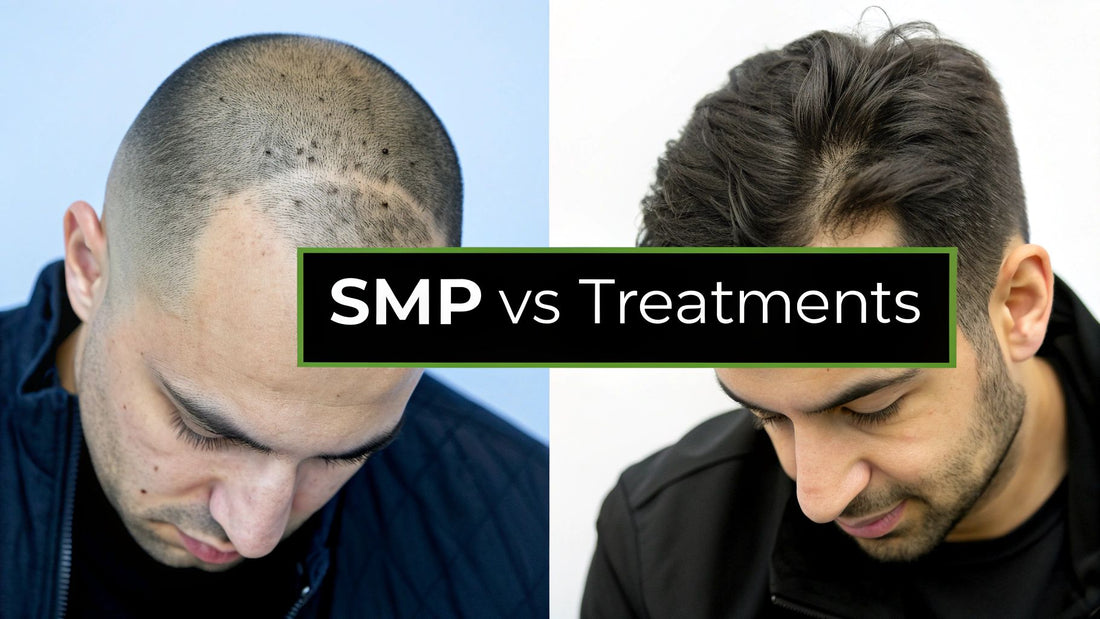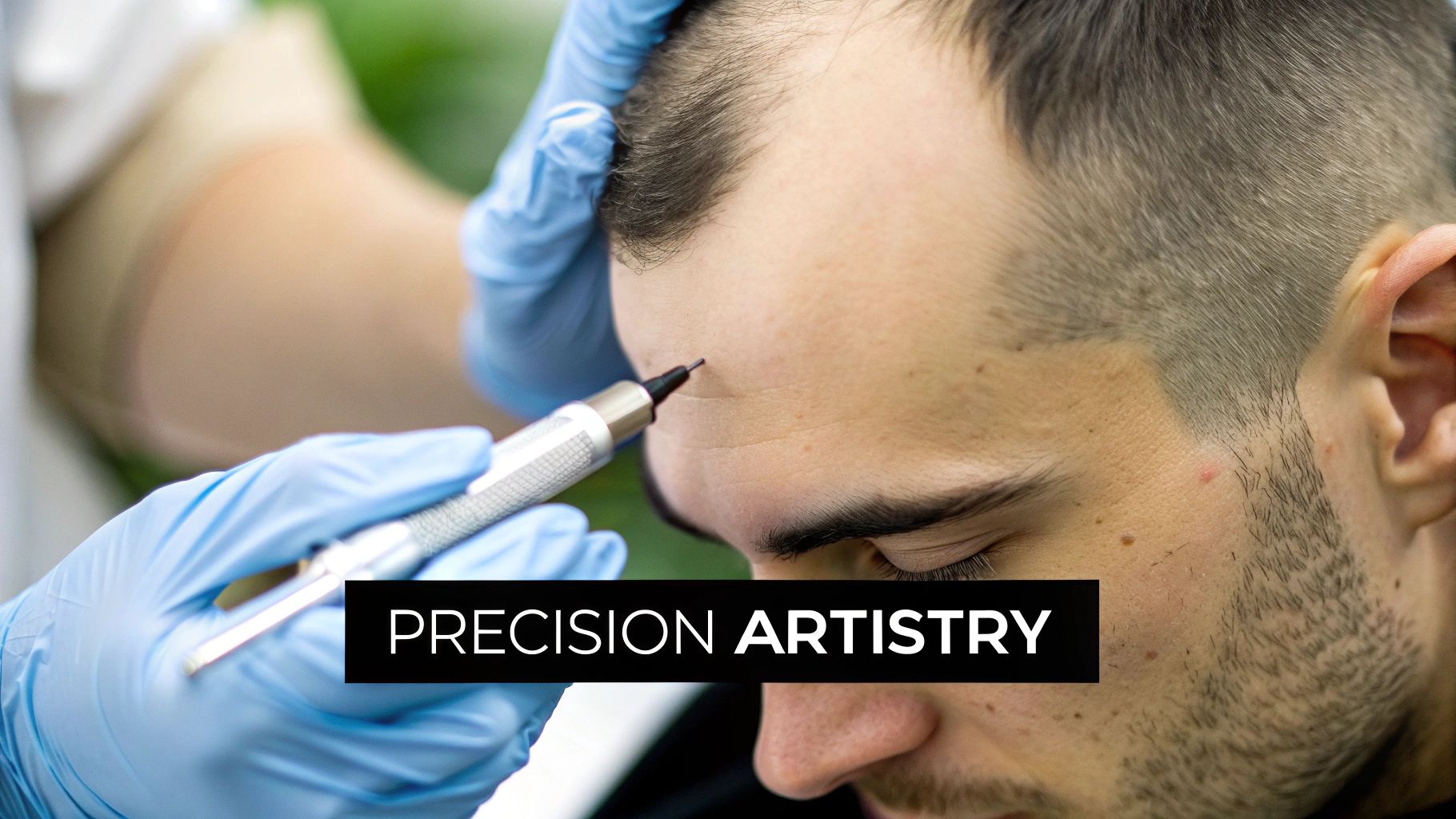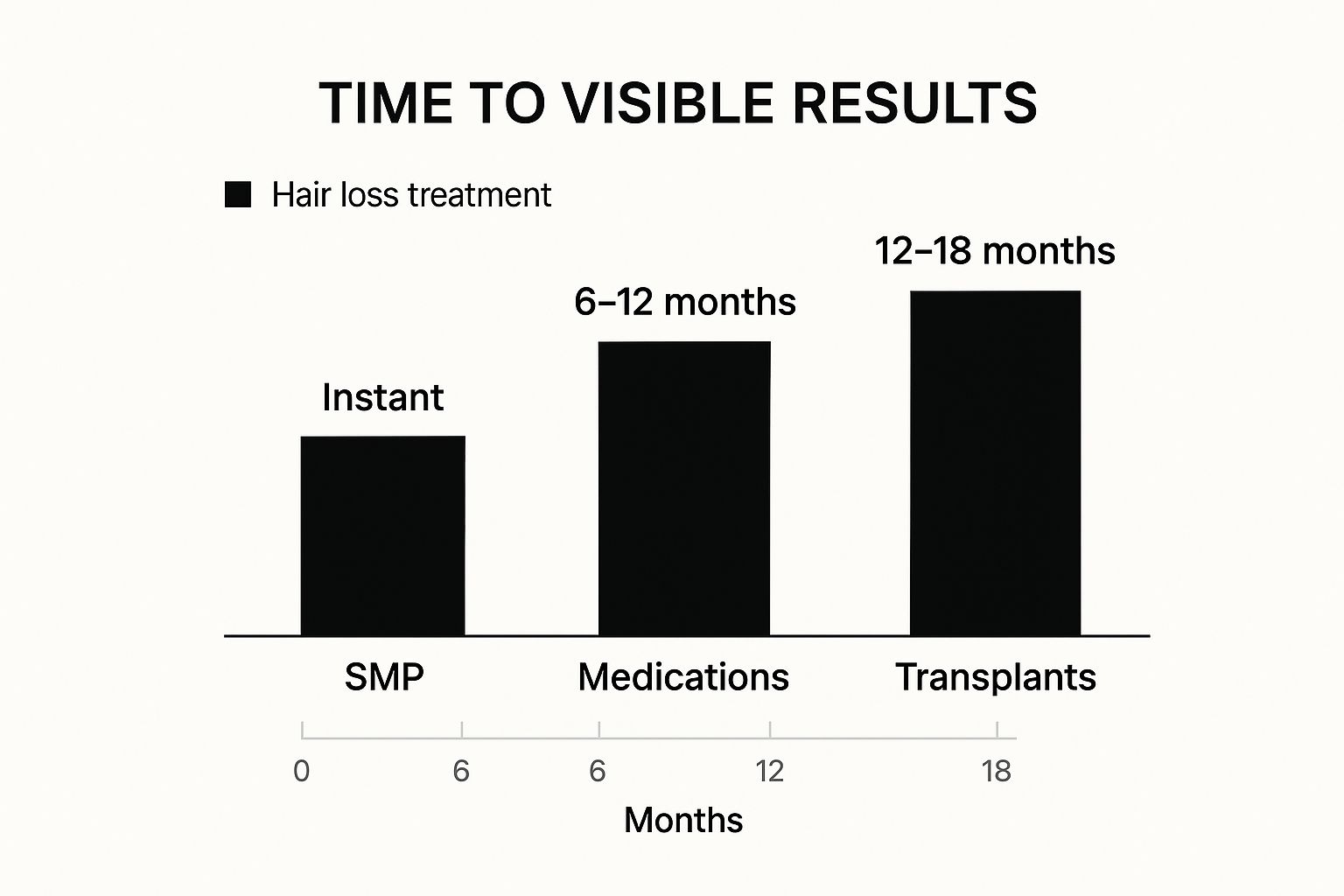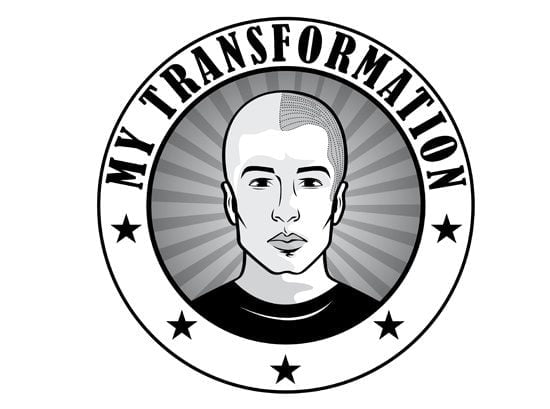
Scalp Micropigmentation vs Other Hair Loss Treatments: Which is Best?
Share
When you're weighing up scalp micropigmentation against other hair loss treatments, it all boils down to one fundamental question: do you want the illusion of hair or the potential to regrow it? SMP is a brilliant cosmetic fix that gives you the look of a full head of hair, while other methods are focused on trying to bring your own hair back. Your decision really hangs on that single point.
Choosing Your Path In Hair Restoration
Trying to figure out the best way to tackle hair loss can feel like a maze. You've got everything from daily medications and topical foams to full-blown surgical procedures, and each one offers a completely different approach. They're designed for different people, with different goals, lifestyles, and stages of hair loss. The best first step is to get a handle on what each one actually does.

Scalp Micropigmentation, or SMP, sits firmly in the cosmetic camp. It’s an incredibly advanced tattooing technique, not a hair growth treatment. Skilled practitioners use fine microneedles to place tiny dots of pigment on the scalp, perfectly mimicking the look of individual hair follicles. The result? Either a sharp, clean-shaven buzz cut look or a subtle increase in visual density for thinning hair.
Then you have the medical and surgical options. These are the ones that aim for actual regrowth:
- Medications: You’ve likely heard of Minoxidil and Finasteride. These are designed to put the brakes on hair loss and, for some people, can kick start dormant follicles into growing again.
- Hair Transplants: This is the surgical route. Procedures like FUE (Follicular Unit Extraction) and FUT (Follicular Unit Transplantation) involve physically moving healthy, growing hair follicles from one part of your scalp (the donor area) to the thinning or bald spots.
Getting familiar with the full range of hair loss solutions for men will give you a clearer picture. Ultimately, it’s about what you’re most comfortable with. Are you after a guaranteed, zero-fuss aesthetic solution, or are you prepared to play the long game with regrowth treatments that can be less of a sure thing?
Hair Loss Treatments At A Glance
To make things a bit clearer, here’s a quick rundown of the main options and how they stack up.
| Treatment | Core Principle | Best For | Cost Level |
|---|---|---|---|
| Scalp Micropigmentation | Cosmetic tattooing to create the illusion of hair follicles. | Guaranteed shaved-head look, adding density, scar camouflage. | Medium |
| Hair Transplant (FUE/FUT) | Surgical relocation of your own growing hair follicles. | Regrowing actual hair in bald areas with good donor hair. | High |
| Medications (Minoxidil) | Stimulating follicles and improving blood flow to the scalp. | Slowing hair loss and potential regrowth in early stages. | Low (Ongoing) |
This table just scratches the surface, but it highlights the core purpose of each treatment to help you see where they fit.
How Scalp Micropigmentation Really Works
It's easy to mistake Scalp Micropigmentation (SMP) for a regular tattoo, but that couldn't be further from the truth. This is a highly specialised cosmetic procedure that's equal parts technical skill and artistic talent. The whole idea is to create a hyper-realistic illusion of hair by carefully placing thousands of tiny pigment deposits into the upper layer of the scalp. Imagine an artist using pointillism, building a complete picture one dot at a time—that’s the level of detail we’re talking about.

A trained technician uses specialised microneedles and a specific, carbon-based pigment to perfectly mimic the size, shape, and angle of individual hair follicles. This isn't a one-and-done job. The process is painstakingly repeated over two to four sessions, usually a few weeks apart. Each visit builds up the density, layering the pigment to create a subtle 3D effect that looks completely natural. It’s this layering that prevents the flat, "helmet" look you might see from an inexperienced practitioner.
The Art of Customisation
Because every person’s hair loss pattern, head shape, and skin tone is unique, no two SMP treatments should ever be the same. A good technician is an artist who customises every detail to suit you perfectly. This isn't a cookie-cutter approach.
Here’s what goes into that customisation:
- Hairline Design: You'll work together with the technician to map out a hairline that looks right for your age and face shape. You can go for anything from a sharp, defined edge to a softer, more naturally receded style.
- Pigment Matching: The pigment is expertly blended to match your natural hair colour and complement your skin tone. Even for clients with grey hair, a skilled practitioner can use diluted pigments to create a perfect salt-and-pepper look.
- Seamless Blending: The new pigment dots are meticulously blended into any remaining hair, ensuring there's no visible line between the treated areas and your existing hair.
It’s this attention to detail that makes all the difference. When you're looking at scalp micropigmentation vs other hair loss treatments, SMP really stands out because the cosmetic results are instant and predictable.
At its core, SMP is about restoring the frame for your face. It's not growing hair back; it's expertly crafting the appearance of a full head of hair that looks intentional, clean, and confident.
This kind of precise, non-surgical solution is seeing a huge surge in popularity across Australia. We're seeing a growth of 15-20% in SMP procedures in major cities like Sydney and Melbourne, with hundreds of treatments being performed every month as more people discover it.
Getting a clear picture of how SMP works for hair loss is the first step to understanding why it's so effective. It’s a solution built on pure artistry, which means the final result is designed just for you.
Comparing Treatment Results And Timelines
When you're weighing up scalp micropigmentation against other hair loss treatments, one of the biggest factors is how long it takes to see the final result. The journey to your desired look can vary massively between cosmetic, surgical, and medical options, which really influences what will fit your lifestyle and expectations.
Scalp micropigmentation is in a league of its own when it comes to speed and predictability. While the complete, layered look is built up over two to four sessions, you walk out of your very first appointment with a noticeable difference. That first treatment lays down the foundational hairline and coverage, so the change is instant. Follow-up sessions are all about refining that look, building up density and adding subtle details for a hyper-realistic finish.
This is a world away from hair transplants. A transplant holds the promise of real, growing hair, but it's a test of patience. After the procedure, it's completely normal for the transplanted hairs to fall out before new growth even begins—a cycle that can take several months.
The Waiting Game: Transplants vs Medications
A hair transplant is a serious investment, not just in money but also in time. It can take a full 12 to 18 months before you see the final, mature results of the surgery. On top of that, the success and density depend hugely on the quality of your donor hair and how well the grafts survive the process. For a closer look at what that journey involves, understanding the stages of hair transplant recovery is a must.
Medications like Minoxidil or Finasteride also demand a long-term commitment. Any results you see are gradual and are more about slowing or stopping further loss than achieving dramatic regrowth. Most people need to wait at least six to twelve months to notice any real change, and that change only lasts as long as you keep using the treatment. If you stop, the hair loss usually starts right back up.
SMP delivers a predictable cosmetic outcome from day one, while a transplant offers the potential for real hair growth but carries surgical uncertainties and a lengthy wait time.
This infographic lays out the difference in timelines pretty clearly, showing how long it takes to see visible results across the main treatment types.

As you can see, SMP gives you an immediate visual impact, whereas other methods require months, or even over a year, to show what they can really do.
Predictability and Guaranteed Outcomes
Ultimately, the choice boils down to what you value most: certainty or potential. With SMP, you get a guaranteed aesthetic from the moment you start. You know exactly what you’re going to get—a sharp, defined buzz-cut look or added density to conceal thinning hair.
In contrast, both transplants and medications are subject to biological guesswork. Not everyone responds well to medications, and a successful transplant isn't a given for every candidate. The final density and coverage can vary widely from one person to the next. SMP simply removes that uncertainty, offering a reliable and immediate cosmetic fix for hair loss.
A Breakdown Of Long-Term Costs And Commitment
When you're weighing up scalp micropigmentation against other hair loss treatments, the initial price tag only gives you a small piece of the puzzle. To get the real picture, you have to look at what it will cost you in money and time over the long haul—we’re talking years, even decades.
Scalp micropigmentation is pretty much a one-and-done deal. Here in Australia, a full treatment will generally set you back somewhere between $1,800 and $4,000, depending on how much ground we need to cover. After your initial sessions are complete, the only thing you'll need to think about is a quick touch-up every three to six years to keep the pigment looking sharp. This makes budgeting for SMP incredibly straightforward.
That predictability is a world away from hair transplants. Yes, they offer the chance for real hair to grow, but the upfront cost is a massive jump. You can read more about how much a hair transplant costs, but you’re often looking at a five-figure investment right out of the gate. On top of that, you might find yourself needing more procedures down the line or paying for ongoing medication to keep your new hair, adding even more to the lifetime cost.
The Cumulative Cost Of Daily Treatments
Topical treatments like Minoxidil play a completely different financial game. The cost to get started is low, which can make it seem like the cheapest way to go. But here's the catch: it only works if you keep using it. Every single day. For the rest of your life. That $50 to $100 a month might not feel like much at first, but over a decade, you’ve suddenly spent $6,000 to $12,000—all without any guarantee of the results you want.
The key financial difference is simple: SMP is an upfront investment with minimal upkeep, while medications are a lifelong subscription with cumulative costs that eventually surpass the price of a permanent cosmetic solution.
And it’s not just a financial commitment. It’s the daily routine of applying foams or swallowing pills, a constant reminder of your hair loss. Honestly, for a lot of our clients, the freedom from that daily chore is one of the biggest draws of SMP. It’s a solution you can just get done and then get on with your life.
Visualising The 10-Year Financial Impact
To really put things in perspective, let's lay out the estimated costs over a ten-year period. This helps us see past the initial sticker price and understand the true cost of ownership for each option.
It’s crucial to analyse the complete financial and time commitment required to not just achieve, but also maintain your desired look over the long term. This table breaks down what you can realistically expect.
Lifetime Cost And Time Investment Comparison
| Treatment | Initial Cost (AUD) | Ongoing Costs | Time Commitment | Estimated 10-Year Cost |
|---|---|---|---|---|
| Scalp Micropigmentation | $1,800 – $4,000 | Touch-ups every 3-6 years | 2-4 initial sessions | $2,500 – $5,500 |
| Hair Transplant | $10,000 – $25,000+ | Potential medication/follow-ups | Surgery + 12-18 month recovery | $12,000 – $30,000+ |
| Medications (Minoxidil) | $50 – $100 | Monthly refills for life | Daily application | $6,000 – $12,000 |
As you can see, while SMP requires a proper investment to get started, it almost always works out to be the most cost-effective choice over a decade. It frees you from the never-ending payments for medications and helps you avoid the hefty initial and potential follow-up costs of surgery. It just gives you a clear, predictable financial path forward.
Finding The Right Treatment For Your Situation
Choosing between scalp micropigmentation and other hair loss treatments isn’t about finding a one-size-fits-all answer. It’s about figuring out what’s right for you. Your age, the pattern of your hair loss, and what you want to see in the mirror all play a huge part in landing on the perfect solution. It really comes down to matching the treatment to your unique circumstances.

Let's walk through a couple of real-world scenarios to see how this works in practice.
The Modern Professional With A Receding Hairline
Picture a professional in his late 20s or early 30s. He’s starting to see his hairline creep back, making his forehead look more prominent. He’s not going bald, but he wants a sharp, clean, and effortless look that screams confidence at work.
For someone in this position, scalp micropigmentation is often the perfect fit. It lets him own a modern buzz-cut style that looks deliberate, not like he’s trying to hide hair loss. SMP creates a defined, natural-looking hairline that frames his face, delivering a guaranteed cosmetic result without the long, uncertain wait times of other treatments.
The Established Man Seeking To Restore His Hair
Now, let's think about a man in his 40s or 50s. His hair loss has settled down, and he still has a solid amount of healthy hair on the back and sides—the "donor area." His main goal isn't just to cover baldness; he genuinely wants to grow his own hair back and wear it longer.
In this situation, a hair transplant might be the better way to go. Since his hair loss has stabilised and he has enough donor hair, he’s an ideal candidate for surgery. He understands the higher upfront cost and knows he'll need to wait 12-18 months for the full results, but his priority is achieving actual, biological hair growth.
The decision often boils down to one key question: Are you looking for a guaranteed, immediate cosmetic fix, or are you prepared to invest in the possibility of real hair regrowth, with all its inherent variables?
Understanding who benefits most from each approach is crucial. For a more in-depth look, check out our guide on who can benefit from hair tattoos for more detailed examples.
Specialised Cases Where SMP Excels
Beyond the typical male pattern baldness, scalp micropigmentation really comes into its own when dealing with tricky situations where other treatments just can't deliver. Its versatility makes it an incredibly powerful solution for a wide range of challenging hair loss issues.
Here are a few scenarios where SMP is uniquely effective:
- Camouflaging Scars: For anyone with scars from old hair transplant surgeries (like those noticeable FUT strip scars) or head injuries, SMP is a game-changer. The pigment can be masterfully blended into the scar tissue, making it practically vanish into the surrounding hair.
- Adding Density for Diffuse Thinning: Many women experience diffuse thinning, where hair becomes finer all over the scalp instead of creating bald patches. SMP can be applied between the existing hairs to create a subtle shadow effect, which cuts down the contrast between the scalp and hair, giving an instant look of greater thickness and fullness.
- Alopecia Areata Camouflage: For people dealing with the patchy hair loss caused by alopecia areata, SMP can expertly fill in the bald areas. This creates a consistent, uniform appearance and can be a massive confidence booster.
Making A Confident And Informed Decision
Choosing between scalp micropigmentation and other ways to tackle hair loss is a big deal. There's no single "best" option for everyone; the right path is the one that fits your goals, your budget, and how you live your life. The best way to get clear on this is to start with an honest chat with yourself.
What are you really after? Is it a guaranteed look, or are you holding out for the possibility of your own hair growing back? Answering that one question will often point you in the right direction. SMP gives you a definite visual result right away, while transplants and medications offer a shot at regrowth but come with a lot more unpredictability and much longer timelines.
Finding Your Personal Best Fit
Think about your day-to-day life and how much maintenance you're willing to put in. SMP is incredibly low-maintenance, really just needing a bit of moisturiser and touch-ups down the track. On the other hand, medications are a daily, lifelong commitment, and hair transplants come with a pretty involved aftercare routine. Your answer here will tell you whether a "set and forget" style solution or an ongoing treatment is a better fit for you.
The right choice empowers you by matching the treatment's core function—cosmetic illusion vs. biological regrowth—with your personal definition of success. A confident decision comes from knowing what you value most.
The growing interest in cosmetic solutions like SMP is happening worldwide, and Australia is no exception. Its popularity here reflects a broader acceptance of aesthetic treatments, driven by changing ideas of what looks good. This isn't just a feeling; the numbers back it up. The global micropigmentation market is projected to grow at a CAGR of around 7.87% to 8.3% between 2025 and 2033. You can read more about these micropigmentation market trends on straitsresearch.com.
Ultimately, the best choice is always an informed one. We can't stress this enough: book consultations with both qualified SMP artists and medical professionals. By getting expert opinions from both sides, you can properly weigh up the pros and cons of scalp micropigmentation vs other hair loss treatments and choose the path that will genuinely bring back your confidence.
Your Questions About Hair Loss Treatments Answered
When you're weighing up scalp micropigmentation against other hair loss treatments, it’s only natural to have a few questions. Getting the right information is the first step towards making a decision you’ll feel great about.
Does SMP Hurt More Than A Hair Transplant?
Everyone’s pain threshold is different, but the general consensus is that SMP is far less painful than a hair transplant. A transplant is actual surgery, even if it's minor. It involves local anaesthetic injections and either removing a strip of scalp or individual follicles, which can lead to some serious discomfort for days afterwards.
SMP, on the other hand, is more like a cosmetic tattoo. Most people I've worked with describe it as a light, repetitive pricking sensation. On a pain scale, they usually rate it a 2 to 4 out of 10. We also use a quality numbing cream to make the whole experience as comfortable as possible.
Can You Get SMP If You've Already Had A Hair Transplant?
Yes, and it’s actually one of the best ways to get an incredible, dense-looking result. I see many clients who have already had a transplant and come to us to take their results to the next level.
Here’s how the two treatments complement each other so well:
- Creating the Illusion of Density: Sometimes a transplant doesn't quite deliver the fullness you were hoping for. We can apply SMP between the transplanted hairs, which adds a 'shadow' to the scalp and makes your existing hair look significantly thicker.
- Hiding Transplant Scars: Older transplant methods, especially the FUT (strip) technique, often leave pretty obvious scars at the back of the head. SMP is fantastic for camouflaging these, blending them in so they practically disappear.
Will My SMP Look Fake When My Hair Turns Grey?
That’s a very common worry, but a good SMP artist plans for this right from the start. We work with specialised charcoal-based pigments, not standard black tattoo ink. This allows us to dilute the pigment to create a huge range of shades.
For clients who are already grey or starting to go that way, we simply mix a lighter, softer shade. The finished look is a natural ‘salt and pepper’ buzz cut that ages right along with you, so the treatment stays completely undetectable.
What Should I Look For In A Reputable SMP Clinic In Australia?
You need to see proof of their work. A top-tier clinic will be eager to show you a big portfolio filled with high-quality before-and-after photos of their actual clients.
Beyond that, look for genuine client reviews you can verify. They should insist on an in-person consultation and be totally open about their qualifications, the equipment they use, and their hygiene practices.
Ready to explore a guaranteed, non-surgical solution to hair loss? At My Transformation, we specialise in creating life-changing, natural-looking results with scalp micropigmentation. Book your free consultation today to see what's possible.
